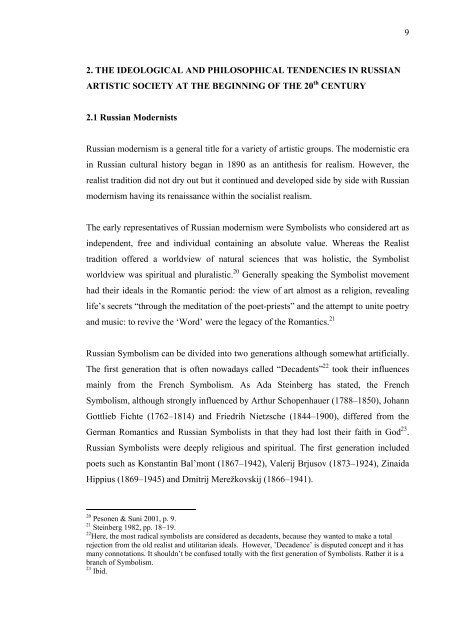Boris Asaf'ev and the Soviet Musicology - E-thesis
Boris Asaf'ev and the Soviet Musicology - E-thesis
Boris Asaf'ev and the Soviet Musicology - E-thesis
Create successful ePaper yourself
Turn your PDF publications into a flip-book with our unique Google optimized e-Paper software.
2. THE IDEOLOGICAL AND PHILOSOPHICAL TENDENCIES IN RUSSIAN<br />
ARTISTIC SOCIETY AT THE BEGINNING OF THE 20 th CENTURY<br />
2.1 Russian Modernists<br />
Russian modernism is a general title for a variety of artistic groups. The modernistic era<br />
in Russian cultural history began in 1890 as an anti<strong>the</strong>sis for realism. However, <strong>the</strong><br />
realist tradition did not dry out but it continued <strong>and</strong> developed side by side with Russian<br />
modernism having its renaissance within <strong>the</strong> socialist realism.<br />
The early representatives of Russian modernism were Symbolists who considered art as<br />
independent, free <strong>and</strong> individual containing an absolute value. Whereas <strong>the</strong> Realist<br />
tradition offered a worldview of natural sciences that was holistic, <strong>the</strong> Symbolist<br />
worldview was spiritual <strong>and</strong> pluralistic. 20 Generally speaking <strong>the</strong> Symbolist movement<br />
had <strong>the</strong>ir ideals in <strong>the</strong> Romantic period: <strong>the</strong> view of art almost as a religion, revealing<br />
life’s secrets “through <strong>the</strong> meditation of <strong>the</strong> poet-priests” <strong>and</strong> <strong>the</strong> attempt to unite poetry<br />
<strong>and</strong> music: to revive <strong>the</strong> ‘Word’ were <strong>the</strong> legacy of <strong>the</strong> Romantics. 21<br />
Russian Symbolism can be divided into two generations although somewhat artificially.<br />
The first generation that is often nowadays called “Decadents” 22 took <strong>the</strong>ir influences<br />
mainly from <strong>the</strong> French Symbolism. As Ada Steinberg has stated, <strong>the</strong> French<br />
Symbolism, although strongly influenced by Arthur Schopenhauer (1788–1850), Johann<br />
Gottlieb Fichte (1762–1814) <strong>and</strong> Friedrih Nietzsche (1844–1900), differed from <strong>the</strong><br />
German Romantics <strong>and</strong> Russian Symbolists in that <strong>the</strong>y had lost <strong>the</strong>ir faith in God 23 .<br />
Russian Symbolists were deeply religious <strong>and</strong> spiritual. The first generation included<br />
poets such as Konstantin Bal’mont (1867–1942), Valerij Brjusov (1873–1924), Zinaida<br />
Hippius (1869–1945) <strong>and</strong> Dmitrij Merežkovskij (1866–1941).<br />
20 Pesonen & Suni 2001, p. 9.<br />
21 Steinberg 1982, pp. 18−19.<br />
22 Here, <strong>the</strong> most radical symbolists are considered as decadents, because <strong>the</strong>y wanted to make a total<br />
rejection from <strong>the</strong> old realist <strong>and</strong> utilitarian ideals. However, ’Decadence’ is disputed concept <strong>and</strong> it has<br />
many connotations. It shouldn’t be confused totally with <strong>the</strong> first generation of Symbolists. Ra<strong>the</strong>r it is a<br />
branch of Symbolism.<br />
23 Ibid.<br />
9

















